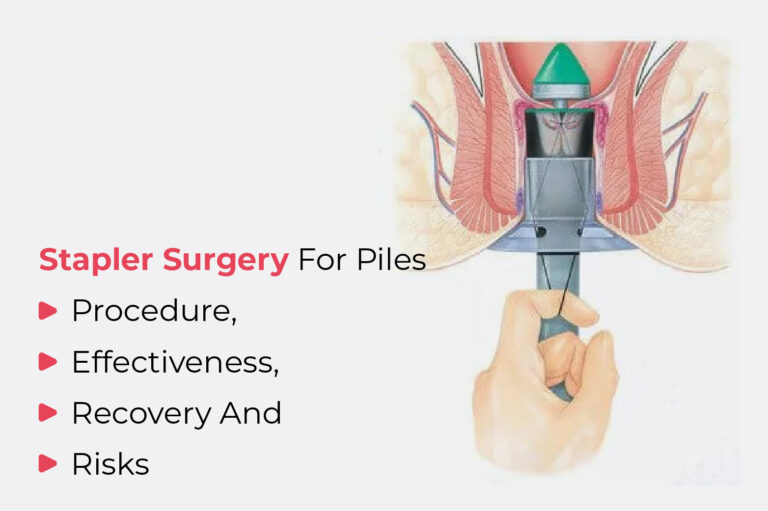Table of Contents
- Why do you need Stapler surgery to treat piles?
- Treatment for piles involves several steps
- Advantages of stapler haemorrhoidectomy
- Bleeding
- Tissue Damage
- Recurrence of Piles
- Pain
- Infection
- Take Away
Hemorrhoids or piles are a common problem for many and are something we would all like to avoid. The hemorrhoids or piles are swellings that come from inflaming of the veins in the rectum, anus, or mucous membranes. It is one of the most common diseases suffered by the elderly, but also it can affect individuals before reaching a certain age. Piles can be caused by straining during bowel movements, pregnancy, being overweight, and having a family history of hemorrhoids.
Hemorrhoids can be a pain to deal with. They tend to cause discomfort and may render you unable to go about your daily routine. The worst part about this condition is that it’s so embarrassing for many people. No one wants to talk about their hemorrhoid symptoms, and there’s even more stigma with getting hemorrhoid treatment. It’s a topic most would rather avoid. But it doesn’t have to be that way. Hopefully, these tips can help you deal with hemorrhoid symptoms without going through surgery or other invasive treatments.
Why do you need Stapler surgery to treat piles?
Stapler surgery is one of the most effective treatments for piles. It is mainly used in cases when patients don’t respond to non-invasive methods like tablets, ointments, and lifestyle changes.
Treatment for piles involves several steps:
- Removal of the internal and external hemorrhoids by cutting or burning.
- The wounds are stitched.
- A stapler device is used to cut off excess tissue from the back passage (anus).
- A stapler device, also called a haemorrhoidectomy device, is usually used to remove piles. It uses staples to close up the tissue that has been removed.
Stapler devices are more effective than other surgical techniques because they do not leave scars on the skin. Staplers also allow your surgeon to remove more tissue than would be possible with other surgical techniques. The procedure takes about 20 minutes, with an average stay in the hospital of about one day. You may need to take painkillers for a few days after you leave the hospital, and you will probably have some discomfort for a week or so afterward. Sometimes it can take longer for the pain to go away completely, and your doctor may prescribe some more potent painkillers if this happens.
Advantages of stapler haemorrhoidectomy
- The stapler hemorrhoidectomy is a minimally invasive procedure, which causes minimal pain and scarring.
- The stapler haemorrhoidectomy is a permanent cure for hemorrhoids.
- It offers a faster recovery time without significant pain after the procedure.
- It has fewer risks and requires less post-operative care than other procedures such as ligation or cryosurgery.
- There is no need to visit a therapist after surgery during the stapler haemorrhoidectomy, as you can resume your normal activities immediately after the operation.
Risks involved in stapler haemorrhoidectomy surgery
1. Bleeding
This is the most common side effect and usually occurs at the time of surgery. The doctor will numb the area with a local anaesthetic to minimize pain. The doctor may also give you a sedative to help you relax during this time. However, there is always a chance of bleeding following stapler haemorrhoidectomy, especially if you take blood-thinning medications such as aspirin or ibuprofen.
2. Tissue damage
The stapling device used during surgery can cause tissue loss, leading to discomfort in your anal canal and rectum. This may cause rectal bleeding or leakage of stool or mucus from the anus. In rare cases, it may be necessary for you to have another operation to repair any tissue damage caused by the stapler device.
3. Recurrence of piles
Though occasional (5-8%), it can happen because some internal piles were not removed during the procedure. If such a case occurs, the doctor will recommend a second procedure to remove the remaining piles or laser treatment to remove them from inside the body.
4. Pain
You may experience mild or severe pain following surgery, depending on your sensitivity to pain. If you experience significant pain after surgery, contact your doctor immediately so that he can provide recommendations on how to manage your pain and discomfort during this time.
5. Infection
If infection occurs following stapler haemorrhoidectomy surgery, it will usually take place within two weeks after the operation. Infection of the wound needs immediate treatment with antibiotics and sometimes removal of the stitches if they are infected. If an infection occurs, it will usually be accompanied by pain and swelling as well as fever and chills.
Take Away
Stapler surgery is a very commonly used technique, and it is effective – It is less invasive than the others. But, this procedure too has some side effects. The doctor should be consulted before opting for any of the procedures because only he can evaluate your piles’ condition and recommend something that will avoid severe issues after the surgery.
In Hyderabad, Vitality’s Laser Piles Clinic is one of the best places to treat piles. Our team of experts, equipped with state of the art equipment and methods for the diagnosis and treatment of different types of piles, perform various diagnostic techniques to determine the type and severity of piles to suggest the treatment plan further. To book an appointment with Vitality’s Laser Piles Clinic, click or call 910 850 3674 now!



